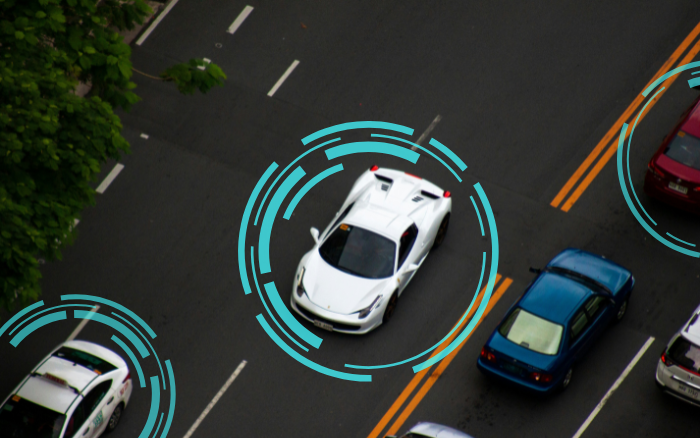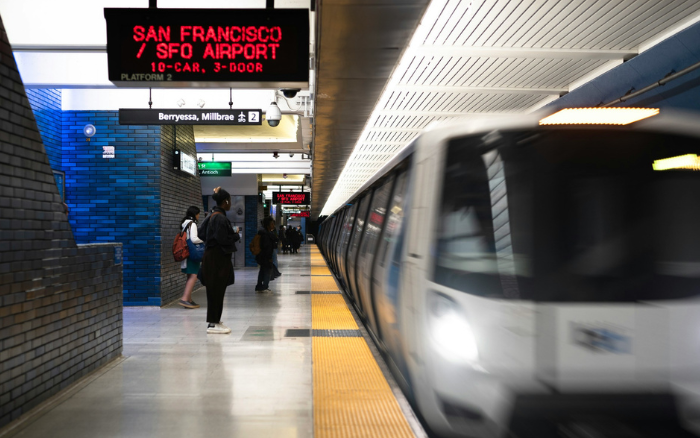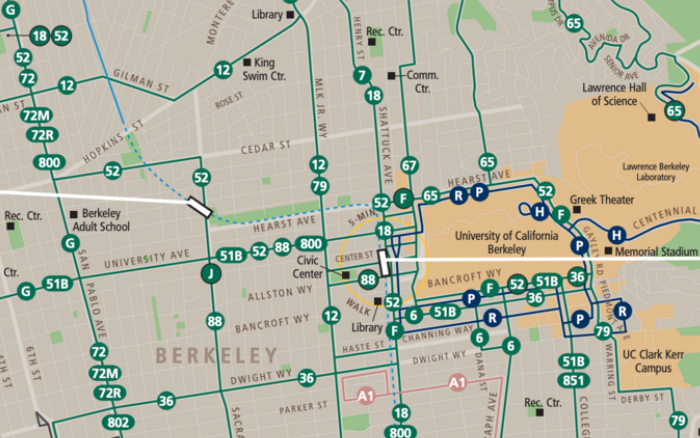California Partners for Advanced Transportation Technology
Our mission is to develop solutions that address the challenges of California’s surface transportation systems through advanced ideas and technologies, and with a focus on greater deployment of those solutions throughout California.
Research Facilities
State-of-the-art facilities where we develop and test innovative transportation solutions.
FEATURED PROJECTS
Seamless & Sustainable Mobility on Demand
Scott Moura, Principal Investigator
This incubation project investigates if a battery swapping station provides a lower total cost of ownership (TCO) and greenhouse gas (GHG) emissions relative to a mega-charging station, for long-haul trucks. It also provides models to optimally plan and operate a battery swapping station. We formulate a mathematical optimization model, solve it, and analyze the results via sensitivity analysis, comparative analysis, progressive feature additions, and case studies.
Field Test of Combined Coordinated Ramp Metering and Variable Speed Advisory for Freeway Traffic Control
Xiao-Yun Lu, Principal Investigator
The objective of this project is to field implement, test, and evaluate the performance of Combined CRM and VSA on SR 99 NB corridor in caltrans District 3 in Sacramento. The project will use a series of roadside VSA signs along the corridor and one or two changeable message signs (CMS) in the upstream section to acknowledge the public driver in advance about the VSA and CRM downstream to gain better driver compliance rate. The project will also develop a website displaying various collected data that can be accessed by the public.
Digital Mobility Assistant for Disabled Transit Users
Alex Kurzhanskiy, Principal Investigator
PATH researchers are working with the disabled community of Contra Costa County through the Center for Independent Living Resources of Solano and Contra Costa Counties (ILRSCC). They are building a knowledge graph (KG) of disabled travelers with their needs, restrictions, preferences, and points of interest (POIs); and mobility services including transit, paratransit and private companies such as Uber WAV with their schedules, coverage areas, cost, etc. As the KG grows, new relationships between existing entities may be discovered. A knowledge update engine is a distinguishing feature of the system. A review-like function will be the core feature of the KG built on the semi-automatic collection of feedback, reviews and surveys which will update user preferences. The information contained in the KG will be accessible through an Application Programming Interface (API) by a functional prototype user interface (UI).The goal of this research is to build a working prototype system that would help generate a travel plan for a disabled person using available mobility options that include transit and paratransit but is not limited to those.
Technical Support to California DMV on Automated Vehicle Regulations
Steven Shaldover, Principal Investigator
This ongoing project, “Technical Support to California DMV on Automated Vehicle (AV) Regulations”, is providing the Department of Motor Vehicles (DMV) valuable insight and support into AV technologies in California. PATH is assisting the DMV in analyzing the data provided by the companies that are testing AVs on California public roads to assess the maturity of the technology and providing technical reviews of the applications that the companies submit when they apply for permits to test without drivers or to put AVs into regular public operation.
V2X Infrastructure for CAV Applications
Kun Zhou, Principal Investigator
California PATH has been devoting efforts to keep the California CV Test Bed fully operational and compliant with the latest national CV standards to support researching, testing, and demonstrating of CV technologies that can enhance the safety and mobility of our transportation system.
Accessibility and Adoption of Shared Automated Vehicles by Disabled Travelers
Peggy Wang, Principal Investigator
This project aims to understand the transportation needs and challenges for people with visual impairment in California, impacts of SAV on accessibility, their future adoption of SAV, and the potential change to their transportation mode choices envisioning having access to SAVs. SB1 Funding. Automated vehicle (AV) technologies are expected to save lives and provide enhanced mobility for all people. In particular, shared automated vehicles (SAVs) could be an attractive means to provide more accessible transportation access for those who cannot drive or face significant barriers to driving. This project will review the literature (peer-reviewed and grey) published to date to identify existing research on the transportation needs and challenges for people with disabilities relative to SAVs, the potential for future adoption of SAVs in this population, and the potential change to their transportation mode choices envisioning having access to SAVs.
Reimagining Sensor Deployment (Task 3942)
Anthony Patire, Principal Investigator
This project reimagines sensor deployment in the context of a near-term possibility where third-party data is procured to obtain travel times and speed data across the state. In this potential future the role of dedicated roadside detection stations would change. It would no longer be necessary to target the deployment of detection stations at every half-mile. Therefore, a new paradigm is required to guide the decisions on where detection stations should be placed to provide the most informational value.that could not be possessed by a current, or prospective, Caltrans employee in the Transportation Engineer, Research Data Specialist, or Research Scientist Engineering classifications. Specifically, this task order scope of work cannot be accomplished within the State civil service system due to the specialized nature of this research regarding: (1) alternative data fusion models utilizing new algorithms; (2) information theoretic approaches to data mining; and, (3) the creation of new standards or guidelines based on the likely performance of innovative algorithms and approaches that are beyond the scope of current practice.
Development and Demonstration for Integrated Dynamic Transit Operations System, Phase II+
Joshua Meng, Principal Investigator
Transit systems were established upon the framework of fixed routes, fixed schedules, and almost-fixed ticket prices. To attract travelers from private driving, transit systems need to be flexible and dynamic. Integrated Dynamic Transit Operation (IDTO) applications show great potential to improve transit service by offering reduced travel time and improved connectivity. This project, an extension of prior Caltrans sponsored work, will test a fully functional IDTO system that delivers improvements to suburban transit services. The IDTO algorithms and user apps are developed to allow holding at bus stops to meet with connecting passengers (Connection Protection or T‐ CONNECT).
After Study for the Richmond San-Rafael Bridge and Sir Francis Drake Pilots (Phase II)
Francois Dion, Principal Investigator
Evaluation of impacts associated with the pilot multi-use path that was opened across the upper deck of Richmond-San Rafael bridge in November 2019 and the pilot modifications that were made to the bike path running across the Sir Francis Drake off-ramp overpass during the summer of 2020. Specific elements evaluated include the use of paths by cyclists and pedestrians, impacts on westbound traffic conditions, impacts on incidents and incident responses, and impacts on maintenance activities. These elements are to be used by Caltrans at the end of the project to determine whether the changes should be kept, in whole or in part.
Statistical Support for the Development of the District 12 Active Transportation Census Program
Alex Skabardonis, Principal Investigator
The California Department of Transport (Caltrans) District 12 proposes to develop a statistically robust bicycle and pedestrian census network to elucidate active transportation volumes, travel patterns, and temporal trends. The census network will be paired with a big data platform to allow estimation of volumes on all roads/trails across the entire District for the first time. The census network design will be optimized to maximize information utility and minimize cost. The findings from this study will be integrated with the findings of the ongoing separate study in District 1 to recommend statistical methods and approach to design a statewide active transportation census network. The overall network design approach will be scalable to facilitate adoption by other Caltrans districts.
LATEST NEWS
Check out the most recent happenings at PATH
-

On the PATH – This Week In Mobility
Transportation News Digest The Bay Area and beyond are in motion. Here’s a quick take on what’s ...
-

On the PATH – This Week in Mobility
Transportation News Digest Here’s what moved the needle this week in mobility: The Bay Area and ...
-

Smart and in charge Integrating zero-emissions vehicles into California’s electric grid
See how PATH Faculty Director, Civil and Environmental Engineering Professor Scott Moura’s ...
-

PATH Receives Nine Caltrans Grants
California Partners for Advanced Transportation Technology (PATH) has been awarded nine projects ...






